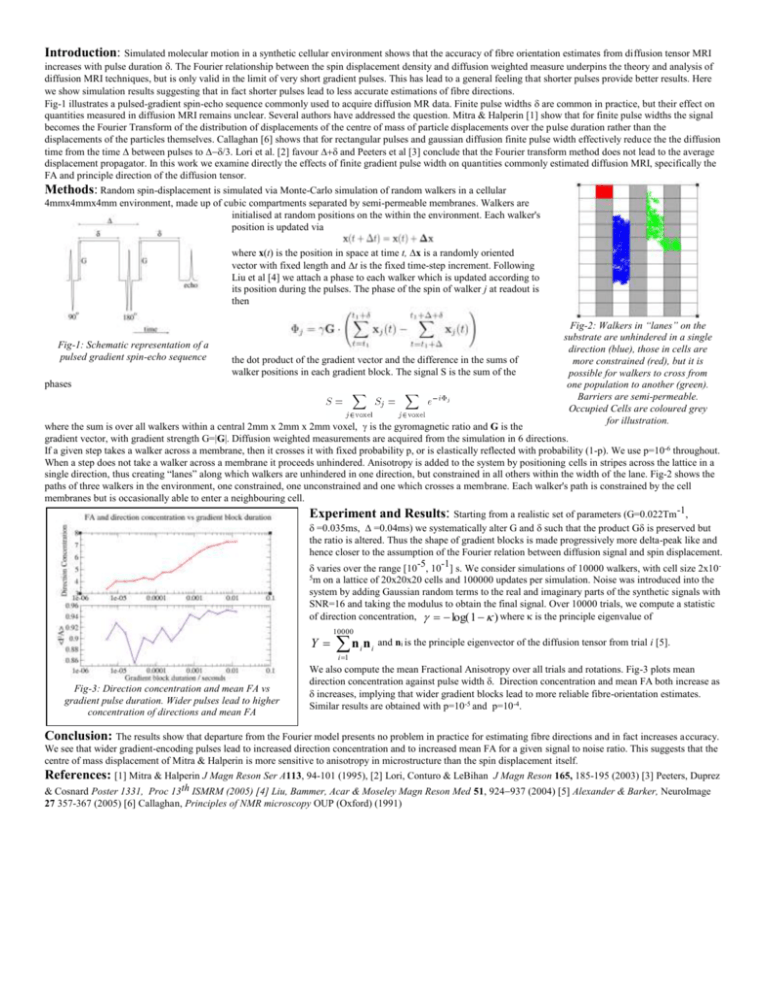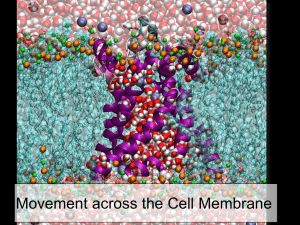HallAlexander2006 - UCL Computer Science
advertisement

Introduction: Simulated molecular motion in a synthetic cellular environment shows that the accuracy of fibre orientation estimates from diffusion tensor MRI increases with pulse duration The Fourier relationship between the spin displacement density and diffusion weighted measure underpins the theory and analysis of diffusion MRI techniques, but is only valid in the limit of very short gradient pulses. This has lead to a general feeling that shorter pulses provide better results. Here we show simulation results suggesting that in fact shorter pulses lead to less accurate estimations of fibre directions. Fig-1 illustrates a pulsed-gradient spin-echo sequence commonly used to acquire diffusion MR data. Finite pulse widths are common in practice, but their effect on quantities measured in diffusion MRI remains unclear. Several authors have addressed the question. Mitra & Halperin [1] show that for finite pulse widths the signal becomes the Fourier Transform of the distribution of displacements of the centre of mass of particle displacements over the pulse duration rather than the displacements of the particles themselves. Callaghan [6] shows that for rectangular pulses and gaussian diffusion finite pulse width effectively reduce the the diffusion time from the time between pulses to Lori et al. [2] favour and Peeters et al [3] conclude that the Fourier transform method does not lead to the average displacement propagator. In this work we examine directly the effects of finite gradient pulse width on quantities commonly estimated diffusion MRI, specifically the FA and principle direction of the diffusion tensor. Methods: Random spin-displacement is simulated via Monte-Carlo simulation of random walkers in a cellular 4mmx4mmx4mm environment, made up of cubic compartments separated by semi-permeable membranes. Walkers are initialised at random positions on the within the environment. Each walker's position is updated via where x(t) is the position in space at time t, xis a randomly oriented vector with fixed length and t is the fixed time-step increment. Following Liu et al [4] we attach a phase to each walker which is updated according to its position during the pulses. The phase of the spin of walker j at readout is then Fig-1: Schematic representation of a pulsed gradient spin-echo sequence the dot product of the gradient vector and the difference in the sums of walker positions in each gradient block. The signal S is the sum of the phases Fig-2: Walkers in “lanes” on the substrate are unhindered in a single direction (blue), those in cells are more constrained (red), but it is possible for walkers to cross from one population to another (green). Barriers are semi-permeable. Occupied Cells are coloured grey for illustration. where the sum is over all walkers within a central 2mm x 2mm x 2mm voxel, is the gyromagnetic ratio and G is the gradient vector, with gradient strength G=|G|. Diffusion weighted measurements are acquired from the simulation in 6 directions. If a given step takes a walker across a membrane, then it crosses it with fixed probability p, or is elastically reflected with probability (1-p). We use p=10-6 throughout. When a step does not take a walker across a membrane it proceeds unhindered. Anisotropy is added to the system by positioning cells in stripes across the lattice in a single direction, thus creating “lanes” along which walkers are unhindered in one direction, but constrained in all others within the width of the lane. Fig-2 shows the paths of three walkers in the environment, one constrained, one unconstrained and one which crosses a membrane. Each walker's path is constrained by the cell membranes but is occasionally able to enter a neighbouring cell. Experiment and Results: Starting from a realistic set of parameters (G=0.022Tm-1, =0.035ms, =0.04ms) we systematically alter G and such that the product G is preserved but the ratio is altered. Thus the shape of gradient blocks is made progressively more delta-peak like and hence closer to the assumption of the Fourier relation between diffusion signal and spin displacement. varies over the range [10-5, 10-1] s. We consider simulations of 10000 walkers, with cell size 2x10 5m on a lattice of 20x20x20 cells and 100000 updates per simulation. Noise was introduced into the system by adding Gaussian random terms to the real and imaginary parts of the synthetic signals with SNR=16 and taking the modulus to obtain the final signal. Over 10000 trials, we compute a statistic of direction concentration, log( 1 ) where is the principle eigenvalue of Y 10000 n n i 1 Fig-3: Direction concentration and mean FA vs gradient pulse duration. Wider pulses lead to higher concentration of directions and mean FA i i and ni is the principle eigenvector of the diffusion tensor from trial i [5]. We also compute the mean Fractional Anisotropy over all trials and rotations. Fig-3 plots mean direction concentration against pulse width . Direction concentration and mean FA both increase as increases, implying that wider gradient blocks lead to more reliable fibre-orientation estimates. Similar results are obtained with p=10-5 and p=10-4. Conclusion: The results show that departure from the Fourier model presents no problem in practice for estimating fibre directions and in fact increases accuracy. We see that wider gradient-encoding pulses lead to increased direction concentration and to increased mean FA for a given signal to noise ratio. This suggests that the centre of mass displacement of Mitra & Halperin is more sensitive to anisotropy in microstructure than the spin displacement itself. References: [1] Mitra & Halperin J Magn Reson Ser A113, 94-101 (1995), [2] Lori, Conturo & LeBihan J Magn Reson 165, 185-195 (2003) [3] Peeters, Duprez & Cosnard Poster 1331, Proc 13th ISMRM (2005) [4] Liu, Bammer, Acar & Moseley Magn Reson Med 51Alexander & Barker, NeuroImage 27 357-367 (2005) [6] Callaghan, Principles of NMR microscopy OUP (Oxford) (1991) Acknowledgements: MGH is supported by EPSRC grant number GR/T22858/01









